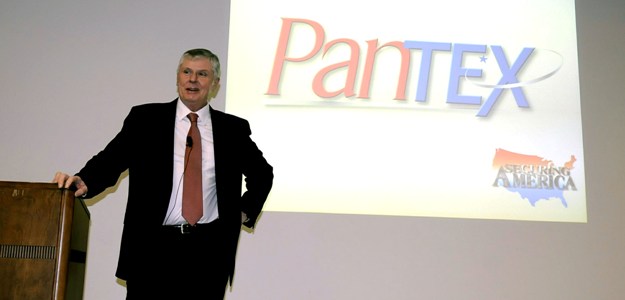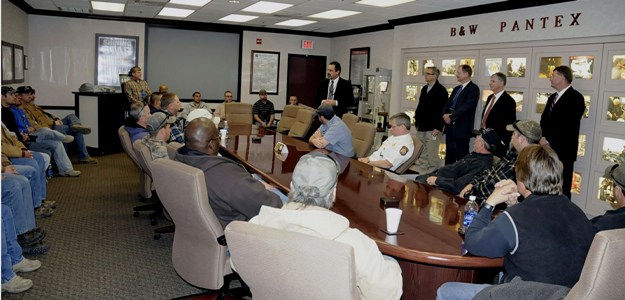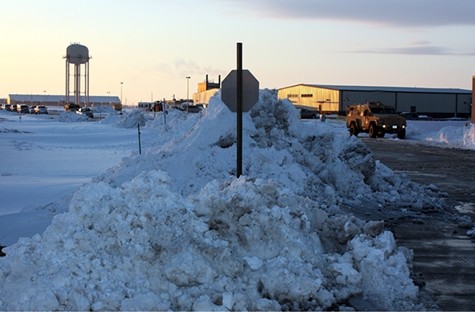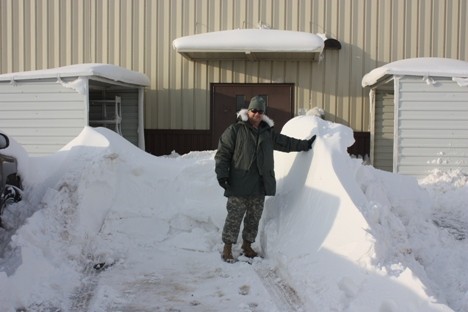Pantex Blog
HASC Leaders Visit Pantex

The two senior leaders of the House Armed Services Committee (HASC) visited the Pantex Plant Tuesday to tour the facility and deliver a message of support to the workers.
U.S. Rep. Howard P. “Buck” McKeon (R-Calif.) told an assembled group of Pantexans he was aware of the critical work done at Pantex through his role as the HASC chairman, but seeing it firsthand really made an impact.
“When I saw that weapon being put together, I was so thankful that you’re all here to do this work,” McKeon said.
McKeon traveled to Pantex with HASC vice chairman, U.S. Rep. Mac Thornberry, whose district includes the Pantex Plant. Thornberry talked about the challenging budget situation facing all levels of government and the importance of maintaining the capabilities of facilities like Pantex.
“What you do here is very, very important, and it needs to be protected,” Thornberry said.
After taking questions from several Pantexans, the two Congressmen concluded the all-hands meeting with a few final words of encouragement.
“(Pantex) is a crown jewel,” McKeon said. “You’ve kept us safe for many years, and you should be congratulated for that.”
HEPF Construction Reaches Halfway Mark
Workers at the Pantex Plant last month finished the largest concrete pour to date on the High Explosives Pressing Facility, completing the last of the elevated soffits, which are part of the roof deck/second story of the building.
The pour marked the completion of approximately 50 percent of the construction on the 45,000 square-foot facility, which will combine high explosives operations from numerous outdated buildings into one state-of-the-art facility which will help to bolster Pantex’s status as the DOE’s High Explosives Center of Excellence for HE manufacturing.
Construction of the $65 million facility is expected to be complete next year. The construction effort is being managed by the U.S Army Corps of Engineers and the design effort/plant support is being led by B&W Pantex/CH2MHill.
Don Cook Visits Pantex

Don Cook, NNSA’s deputy administrator for Defense Programs, last week spoke to Pantexans about the future mission of Pantex and the critical role the plant will play in maintaining the nation’s stockpile for decades to come. During the visit, Cook congratulated some of the 100-plus Pantexans who helped to secure the plant and conduct recovery operations during and after the Feb. 25 blizzard that dropped more than 19 inches on the Amarillo area.

Record Blizzard Hits Pantex
When the biggest blizzard in 70 years is bearing down on your nuclear weapons facility, you’d better have a good plan and a dedicated group of people to execute that plan.
 The Pantex Plant was fortunate to have both those elements in place on February 25 when a massive blizzard dumped 19.1 inches of snow – the second highest total ever recorded in Amarillo – on the plant. To make matters worse, 70-mile-per-hour winds whipped up drifts ten feet high.
The Pantex Plant was fortunate to have both those elements in place on February 25 when a massive blizzard dumped 19.1 inches of snow – the second highest total ever recorded in Amarillo – on the plant. To make matters worse, 70-mile-per-hour winds whipped up drifts ten feet high.
More than 100 dedicated Pantexans spent the next 48 hours helping to dig out and secure the plant, enabling the nation’s primary nuclear weapons assembly plant to return to operations after only two days of lost work.
Most importantly, the massive recovery effort and return to work were accomplished without a single lost time injury and no substantial damage to facilities or property.
Forecasters were predicting the looming blizzard could be a record breaker, so the Pantex Yard Group broke out the snow plan and started looking for volunteers several days before the snow started falling. Nearly 30 members of the Yard Group stepped up to help ensure the plant could weather the storm. They were joined by more than 100 Security Police Officers, firefighters, plant shift superintendents, equipment mechanics and emergency services dispatchers who were prepared to ride out the storm.
“It just shows how selfless our people are, because every one of them had families that were snowed in while they were out here,” said Plant Maintenance Department Manager Lew Monroe.
“They made a conscious decision to be here to help ensure this facility recovered and returned to operation.”
Operations at the Plant were suspended late Feb. 24 in advance of the storm, and when it finally arrived, snow quickly overwhelmed the efforts of the Yard Group. Heavy snow was compounded by howling winds that created huge drifts and reduced visibility to essentially zero. Snow accumulated so quickly and so deeply that four-wheel-drive security vehicles and even a fire truck became stuck in the snow.
After a couple hours of working in whiteout conditions, the Yard Group was forced to retreat indoors and hunker down. As soon as the snow stopped, workers moved out into the howling wind with heavy equipment to start clearing paths through the drifts.
 To ensure safety, the workers operated in teams of two or three to start clearing the 57 miles of paved roads and 28,000 linear feet of sidewalks scattered across the 16,000-acre site. David Taylor, yard group supervisor, said many of the equipment operators have decades of experience at Pantex and know the plant like the back of their hand.
To ensure safety, the workers operated in teams of two or three to start clearing the 57 miles of paved roads and 28,000 linear feet of sidewalks scattered across the 16,000-acre site. David Taylor, yard group supervisor, said many of the equipment operators have decades of experience at Pantex and know the plant like the back of their hand.
“All of our crews who volunteered to come out take great pride in what they do,” Taylor said. “They see it as a service to this country to make sure this Plant is taken care of.”
The crews immediately focused on opening critical areas of the plant to ensure security and emergency services were able to move freely. The battle was nonstop, as the winds continued to whip the snow around, often requiring roads to be plowed three or four times. The snow caused significant issues with the electrical distribution system, requiring several of the plant’s high voltage teams of electricians to brave the weather to help keep the electrical system at the plant operational.
For 48 hours, work crews battled the elements, working long shifts and sleeping where they could before finally being able to declare the plant open for operations Wednesday morning.
“As these guys were leaving the plant, they were glad to go and get some rest. But a lot of them were still worried about whether they’d done enough,” said Yard Group Supervisor Vance Morrison. “That tells you just about all you need to know about their dedication.”
New Method of Polyurethane Mixing Brings New Opportunities
by Paul Lamonica, 2012 Summer Intern
This year, the B&W Pantex Plastics Shop began formulating a new method of mixing polyurethane molded parts for explosives, coatings, seals, cushions, tool covers and more. The old method consisted of mixing the components in a generic “ice cream bucket.” After the correct amounts of materials were mixed together, the mixture would be carefully injected into the mold to form the needed part.
At first glance, this process appears simple, but it took approximately two to three hours to make one mold. In addition, the cleaning process could expose people to hazardous chemicals. Some of the molds formed bubbles and voids after the mixture was injected. After rising concerns about the old mixing method, the Plastics Shop knew that it was time to start researching better
alternatives.
Months were spent researching solutions, and the group discovered a revolutionary type of mixer. This eco-friendly system, known as the dynamic mixer, resolved all of the previous problems with the ice-cream-bucket method.
When the dynamic mixer arrived in February, the Plastics Shop teamed with West Texas A&M University (WTAMU) to give students the opportunity to be engaged with this research. The mixer is residing at the university for research purposes, and Stephanie Steelman, a polymer chemist in the Explosives Technology Division, is the project manager and principal investigator for the
WTAMU collaboration.
Devin Cook and Matt Dolezal, both mechanical engineering majors at WTAMU, have been working on this project since the beginning of this year.
Cook, a senior, has been working on the mold designs and optimizing software specifically for the dynamic mixer. “Engineering today is mainly done on computer, and having knowledge of all this software and technology will benefit me in the future,” said Cook.
Dolezal, who graduated from WTAMU in May, has been working with the mechanical engineering and chemistry research of the project, although both work together on all areas of the project. “I really enjoy how much I’ve learned from this experience; I think the knowledge and
skill sets I’ve gained will help me greatly starting my career,” said Dolezal.
Using the dynamic mixer, it now takes only a few minutes to produce each mold. There is minimal cleanup with no exposure to chemicals and there are no bubbles within the mold. The largest mold, which takes about five pounds of material, requires only three to four minutes to fill.
The project will be finished later this year, and the mixer will reside at Pantex starting sometime in March. “The new mixer will save the Plant money in the form of time, raw materials and personnel resources,” Steelman said.
Each year, the old method cost to the Plant is approximately $100,000 just in packaging and weighing materials for the Plastics Shop to use. The dynamic mixer will allow the Plastics Shop to decrease raw material and rejected parts by at least 80 percent and reduce employee hours and resources repackaging raw materials, said Steelman.

